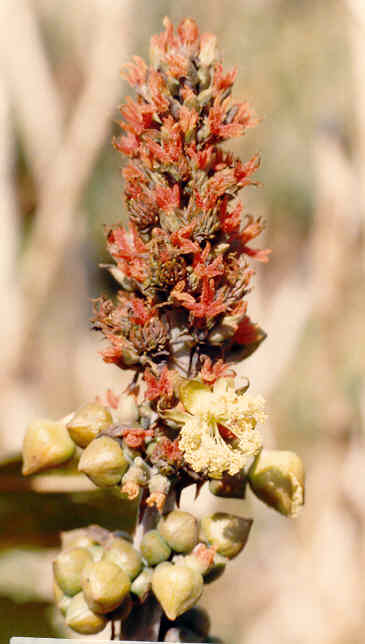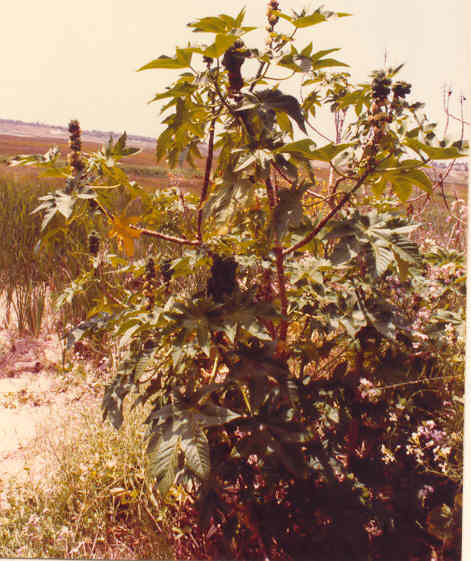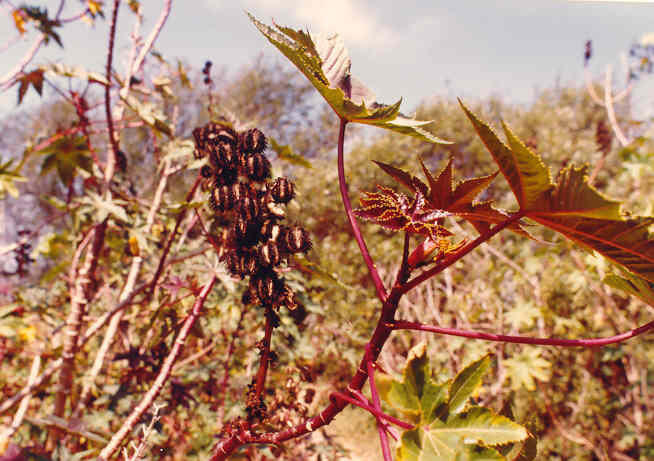
Ricinus communis L.
 |
Ricinus communis L.
Euphorbiaceae (Spurge Family)EuropeCastor Bean |
February Photo
Plant Characteristics:
Monoecious, arborescent shrub, 1-3 m. tall; leaves 1-4 dm. broad,
palmately 5-11 lobed, the lobes serrate; petioles with conspicuous glands; fls.
in racemose or panicled clusters, the female above the male; calyx 3-5 parted;
petals 0; disk 0; stamens many, the fils. much branched; Ovary 3-celled,
3-ovuled; styles 3, bifid, plumose, red; capsule soft spiny, 10-20 mm. thick,
seeds compressed, oblong-ellipsoid, 10-14 mm. long, lustrous-silvery and brown,
+/- mottled, the caruncle 3-4 mm. wide, flattish.
Habitat: Frequent as an escape in waste places below 300 m. Native of the Old World. Flowers most of the year.
Name:
Named for the Medit. sheep tick, Ricinus,
because the seed looks like a tick. (Munz,
Flora So. Calif. 417).
Latin, communis, growing in a society.
(Jaeger 64). The species
name may refer to the growth pattern of the plant, which is usually in colonies.
General:
Common in the study area, with heavy stands in Santa Ana Heights.
Photographed in Santa Ana Heights and Big Canyon.
(my comments).
The beans are poisonous when eaten and may cause local irritation when
handled. (Robbins et al. 287).
Livestock, including poultry, have been poisoned by the plant but it is
not clear whether from eating the leaves or the seeds.
Castor oil is made from the beans and it is toxic to humans even though
it has long been used as a laxative. (Dale
108). Some plant
poisons are easily removed by extracting them in water; others such as the
compounds in castor bean and botulism are inactivated by heat.
Castor bean contains a phytotoxin, a protein which is denatured or
inactivated by heat. Fortunately,
it is not soluble in oil. Hence,
castor oil technically is not toxic. (Kingsbury 73).
As a cathartic and purgative, it has a mild action and so is highly
recommended for young children and child-bearing women.
It is usually taken in fresh or warm milk to disguise the oily taste.
In addition to cases of constipation, it is also valuable in cases of
colic, marked by cold extremities and hard and distended abdomens in infants.
It is also valuable in cases of diarrhea resulting from slow digestion
and after some herb has been administered to destroy worms castor oil may be
applied externally for itches, ringworm and cutaneous complaints.
In some areas, native women have used the fresh leaves of the castor bean
plant as a poultice for application to the breasts to increase milk secretion.
(Kadans 86).
The seeds contain a strong poison called ricinine, as few as two seeds
can be fatal if chewed and swallowed. In
its mildest form, ricine poisoning produces a burning sensation in the mouth; in
severe cases it produces violent convulsions and death from failure to breathe.
Castor oil is not poisonous, but the remains of the seeds after the oil
has been squeezed from them are still dangerous.
These squashed seeds, which are known as "press cakes," have
been accidentally fed to farm animals with disastrous results. (Eshleman 142, 143).
Castor oil is a valuable lubricant for machines.
(John Johnson).
In all other plants forming alkaloids, they occur as mixtures.
R. communis is the only species
found to have a single alkaloid. (Fuller
339). The
Cahuilla, Indians of the Colorado Desert, the San Bernardino and San Jacinto
Mountains are said to have crushed the seeds into a greasy substance that was
used in relieving sores. (Bean and
Saubel 133). The
plant is regarded as a mosquito repellent.
(Hutchens 51). There
is little danger if the hard coated seeds are swallowed whole.
Handling of the seeds of the many varieties of this plant can result in
serious allergies in some individuals. (James
22). Scientists in the late 19th century succeeded
in extracting the toxic protein from the castor plant and named it ricin.
Near the end of World War I, the U.S. military began studying ricin as a weapon.
With British help, the Americans made a ricin bomb in World War II but
apparently never used it. Experts see ricin as a growing terrorism
threat because the toxin is easy to make and stockpile. Ricin’s prospects as a weapon of mass destruction are
mixed. While there is no treatment or vaccine to counter its deadly
effects it is harder to disseminate than a liquid, limiting its spread through
the air. Also, it does not absorb readily into the skin and if
administered orally it must be in a fine powder form. The deadliest method
of dissemination is injection. (Broad, William J. “U.S. Examined Ricin as a
Deadly Weapon” Orange County Register 12 Jan. 2003: A2).
Federal investigators focused Tuesday on identifying the
letter that may have carried the ricin discovered in a senator’s mail room.
An initial check in the criminal investigation found no extortion threat or
complaint letter in the office of Senate Majority Leader Bill Frist, where the
ricin was found. There were also no indications of involvement by foreign
terrorists, which the FBI has said is interested in using ricin in an attack.
The article gave the following facts on ricin: Per gram it is 6000 times more
poisonous than cyanide; can be fatal when inhaled, ingested or injected; very
toxic to cells, damages all organs; no vaccine available; symptoms include
weakness, fever, cough, seizures, lung damage, heart failure and upset stomach.
(Fram, Alan and Anderson, Curt “Ricin probe turns to Capital mail. Senate
buildings shut as teams work to determine if poison was a terrorist act.” Orange
County Register 4 Feb. 2004. News 13.) One
variable species with many horticultural forms. (Munz, Flora
So. Calif. 417).
Text Ref:
Hickman, Ed. 576; Munz, Calif.
Flora 164; Munz, Flora
So. Calif. 417.
Photo Ref:
May 1 83 #23; Feb. 1 85 #22,23.
Identity: by R. De Ruff.
First Found: February 1985.
Computer Ref: Plant Data 30.
Have plant specimen.
Last edit 3/7/04.
 |
 |